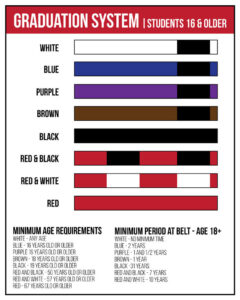Introduction
There is a lot of debate in the world of BJJ over how many belts there should be, and when they should be introduced. But no matter how many belts there are (and there are definitely more than five) or what colours they are (and there are many), every adult BJJ student has to earn their way through them before they can move on to the next level. So whether you’re just starting out or trying to decide which class is right for you, here’s how each colour belt gets awarded!
The White belt
The white belt is the beginning of your journey. It’s a time to learn, grow and develop as a martial artist. The goal is to get promoted to blue belt at some point in the future (or even purple or brown if you’re really good).
The Blue belt
The blue belt is the second lowest belt in Brazilian Jiu-Jitsu. It is often considered an “intermediate” level, as it’s not uncommon for people to take several years to reach this rank after their first black belt promotion. While there are some exceptions, most blue belts should have a good understanding of all the fundamental techniques in BJJ and be able to apply them effectively on the mat.
Blue belts are also expected to understand how each technique interacts with other positions, such as how guard passes work against different types of guard positions or sweeps against particular stand-up positions.
The Purple belt
The purple belt is the first belt that is not a beginner’s belt and it’s a symbol of achievement. It can take a long time to earn, but if you’re serious about your Jiu-Jitsu journey it will be well worth the wait!
To earn your purple belt, you will need to know all the basic techniques in Brazilian Jiu-Jitsu including:
- How to escape from various positions (mount, side control etc.)
- How to pass guard and sweep someone who has passed your guard
The Brown Belt
- Brown belt
The second highest rank in Brazilian Jiu Jitsu, brown belts are considered high-level practitioners and often have a lot of technical knowledge. They’re usually instructors or good sparring partners.
The Black Belt
The black belt is the highest belt in Brazilian Jiu-Jitsu. You will only be awarded a black belt after you have been training for several years, and you must be able to teach others as well as defend yourself against attacks from other people who are trying to hurt you.
The Red and Black Belt
After the 6th degree on a black belt, plus an additional seven years of training, a practitioner is eligible for a red and black belt. To be eligible for a red and black belt, you must have been awarded your black belt 31 years prior. Coral belts (as they are commonly known) have attained a high level of expertise in Brazilian jiu-jitsu, and are commonly referred to by the term “master” among the community of practitioners.
The Red and White Belt
After obtaining the red and black belt, a practitioner must hold this rank for another 7 years before receiving their 8th degree. For their 8th degree, they are awarded a red and white patterned coral belt.
Black belts are revered in Brazilian Jiu Jitsu because they represent the highest level of technical knowledge available within our sport; only those who have dedicated their lives to learning about BJJ can earn this prestigious honorific title.
The Red Belt
The red belt in BJJ, or the 9th-degree black belt, is the highest honour one can achieve in the sport. Renzo and Royler Gracie said that the red belt is reserved “for those whose influence and fame take them to the pinnacle of art.” One must hold their 8th-degree belt for 10 years before being eligible for the red belt. This essentially means that, in order to get a red belt, you would have to be a practising black belt for 48 years. 10th-degree belts also exist but were only given to the original pioneers of Brazilian Jiu-Jitsu, none of whom are still alive today. Red belts are generally referred to as “grandmasters.”
The red belt can be earned by anyone regardless of age, but it’s often given to people over 40 years old. The exception is if you’re under 30 years old and have been training for 10+ years (with proof), then maybe you’ll get one too!
There are a lot of belts to earn in Brazilian Jiu Jitsu
- There are a lot of belts to earn in Brazilian Jiu-Jitsu. The belt system is a way to show your progress, and it’s important because it helps you see if you are improving or not.
- This doesn’t mean that you should compete with other students, or try to win matches against them! Instead, focus on learning new techniques and getting better at them every day. You’ll be proud when your instructor gives you your next coloured belt!
Conclusion
Well, that’s all the belts in Brazilian Jiu-Jitsu! We hope this article has helped you understand what each colour of the belt means.


